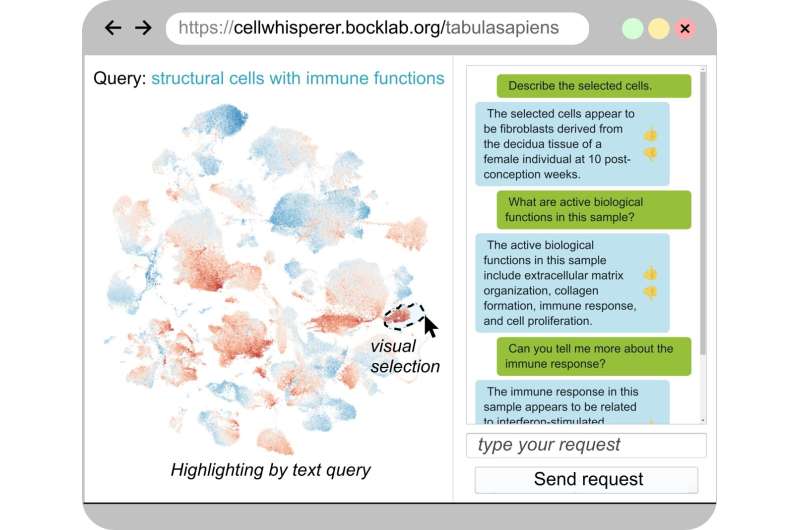Science
Researchers Develop AI Tool to Enhance Single-Cell Analysis

Biomedical researchers are now equipped with a groundbreaking AI tool designed to facilitate the analysis of single-cell data. Developed by a team led by Christoph Bock at the CeMM Research Center for Molecular Medicine of the Austrian Academy of Sciences, CellWhisperer promises to streamline how scientists interact with complex biological datasets.
This innovative software utilizes advanced RNA sequencing technology to map gene activity across millions of individual cells. As the volume of data generated from these analyses grows, so does the need for effective interpretation methods. Researchers often face the challenge of combining their biological knowledge with technical skills to extract meaningful insights from this data. CellWhisperer addresses this issue by acting as a virtual research assistant that simplifies the data exploration process.
Revolutionizing Data Interaction
Published in Nature Biotechnology on November 11, 2025, the study illustrates how CellWhisperer enables users to engage with their data using natural language queries. By linking gene expression profiles with descriptive texts, researchers can ask questions in plain English, such as “Show me immune cells from the inflamed colon of patients with autoimmune diseases.”
The tool employs multimodal deep learning to analyze gene activity alongside curated biological text from public databases. This integration allows researchers to search extensive datasets efficiently, providing insights into the biological underpinnings of various diseases. As co-first author Moritz Schaefer, now at Stanford University, notes, “By training on experimental data of 20,000 studies from the last two decades, CellWhisperer learned about the biological roles of genes and cells.”
Furthermore, CellWhisperer incorporates a large language model that mimics the dialogue typically exchanged between biologists and bioinformaticians. This feature enhances the user experience, making interactions feel akin to discussing findings with a knowledgeable colleague.
Applications and Impact on Research
The researchers demonstrated the potential of CellWhisperer by applying it to single-cell RNA sequencing data related to human embryonic development. By issuing straightforward queries such as “heart” or “brain,” the AI identified crucial developmental markers, cell populations, and time points associated with organ formation. Some of these markers aligned with known developmental genes, while others highlighted previously unrecognized candidates.
Peter Peneder, another co-first author and researcher at the St. Anna Children’s Cancer Research Institute, remarked on the significant impact CellWhisperer has on understanding cellular behaviors. “Science is teamwork, and with CellWhisperer, an AI research assistant has joined our team,” he stated. “It supports and empowers us as human scientists, especially in exploratory research.”
The user-friendly interface of CellWhisperer, built upon the popular CELLxGENE browser, is freely accessible online, democratizing access to advanced data exploration tools in the biomedical field. As researchers continue to navigate the complexities of single-cell analyses, innovations like CellWhisperer stand to play a vital role in enhancing collaboration and discovery.
The development of CellWhisperer marks a significant advance in the integration of artificial intelligence into biomedical research, supporting scientists in their quest to unravel the intricacies of life at the cellular level.
-

 Top Stories2 weeks ago
Top Stories2 weeks agoMarc Buoniconti’s Legacy: 40 Years Later, Lives Transformed
-

 Health3 weeks ago
Health3 weeks agoInnovative Surgery Restores Confidence for Breast Cancer Patients
-

 Sports4 weeks ago
Sports4 weeks agoSteve Kerr Supports Jonathan Kuminga After Ejection in Preseason Game
-

 Top Stories2 weeks ago
Top Stories2 weeks agoBOYNEXTDOOR’s Jaehyun Faces Backlash Amid BTS-TWICE Controversy
-

 Science4 weeks ago
Science4 weeks agoChicago’s Viral ‘Rat Hole’ Likely Created by Squirrel, Study Reveals
-

 Lifestyle4 weeks ago
Lifestyle4 weeks agoKelsea Ballerini Launches ‘Burn the Baggage’ Candle with Ranger Station
-

 Entertainment4 weeks ago
Entertainment4 weeks agoZoe Saldana Advocates for James Cameron’s Avatar Documentary
-

 Politics4 weeks ago
Politics4 weeks agoDallin H. Oaks Assumes Leadership of Latter-day Saints Church
-

 Business4 weeks ago
Business4 weeks agoTyler Technologies Set to Reveal Q3 2025 Earnings on October 22
-

 Lifestyle4 weeks ago
Lifestyle4 weeks agoDua Lipa Celebrates Passing GCSE Spanish During World Tour
-

 Health4 weeks ago
Health4 weeks agoCommunity Unites for Seventh Annual Mental Health Awareness Walk
-

 Health3 weeks ago
Health3 weeks ago13-Year-Old Hospitalized After Swallowing 100 Magnets









